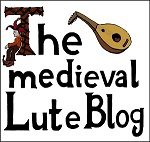The image below roughly shows how the medieval lute was constructed, for those who are entirely new to the subject matter.

Five-course medieval lute by Jo Dusepo [London, August anno 2019]
Here you can download the image:
Basic construction principles
Regarding the construction, the body of the medieval lute was made from thin wooden ribs being glued together. I have seen anything from 5 to 9 ribs being used. The woods that were used were mostly local European woods, such as fruit tree woods, maple, rosewood, yew, flower ash and ebony. The ribs were treated with water and a hot bending iron afterwards, then stretched over a blank and finally glued together, forming the characteristic “bowl-like” structure. The body of the lute would be round in the initial stages of the European lute, still resembling its ancestor, the Oud, but would be built clearly pear shaped, especially from the late 14th century onwards.
The soundboard was glued on the body and could have one, two, or more soundholes (as in the Arabic Oud). The bridge would typically be made from very solid woods and also just be glued on the soundboard. The neck itself could have been attached to the body by glueing or by nailing – or even both. The nut would often be carved from bone or solid wood. The connection between the neck and the pegbox was glued, but possibly also nailed to give extra stability to the construct. The pegbox was attached in a rectangle to the neck. In terms of the glue, the most likely material of choice seems to have been bone- or hide glue. For the finish of the lute back, neck and pegbox, wax-polishing, a sealing with egg white, or even just oiling the surface of the lute several times, seem to have been the most available and therefore common techniques. In later stages, French polish was introduced to seal the back and possibly even the fingerboard of the lute, but clearly never the soundboard, as this would absorb most of the instruments’ resonance. The fretting was done probably mostly by tying gut-string material around the neck, but there might have been exceptions to that as well. The rosettes were carved into the soundboard or added by other materials, such as parchment, getting more and more complex as the Middle Ages progressed. In terms of decorations, inlays and ornaments were used on the soundboard as well as on the fingerboard. The iconographic sources of earlier medieval lutes often indicate an Oriental kind of style when it came to the lutes decorations. Inlays were made from wood, ivory or mother of pearl. The soundboard would sometimes have several soundholes with carvings, pyrographys and paintings around them or someplace else on the soundboard. As building a lute is such a complex and time consuming process, the luthier surely was a respected handyman (or woman?) in his/her society and was also seen as a type of an artist as well. It surely does take a lot of skilled craftsmanship to built a decent lute and that is also why medieval lutes are still as expensive today.
Stringing
Lute strings in the Middle Ages would typically be made from gut – today nylon and nylgut are less expensive but still workable alternatives – professionals use gutstrings nowadays, primarily. The courses (double-strings) would be tuned in unison, mostly (there might also have been exceptions). The course with the highest pitch would be a single string (also known as “chanterelle”) but there also existed lutes that had a double stringing as in the lower courses, especially when the lute still had four courses. Generally spoken, the iconographic sources do not really indicate a standard-stringing in medieval lutes at all. The same is being assumed for the tuning, apart from some basic rules.
